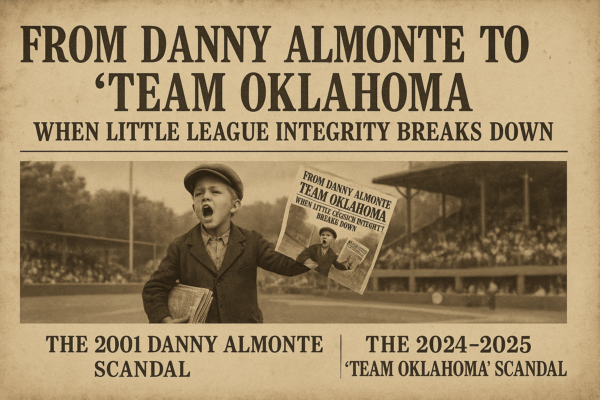The 2001 Danny Almonte scandal became a global cautionary tale for Little League Baseball: a star pitcher, celebrated for his dominance, was revealed to be two years over the age limit. It exposed weaknesses in record-keeping and verification, but the scandal was self-contained—a single player, a single team, one fraudulent act that tainted an otherwise thrilling Little League World Series.
By contrast, the unfolding Team Oklahoma scandal (2024–2025) is not about one forged birth certificate; it is about a systemic pattern of roster manipulation, selective waivers, and secrecy at the regional level. Where the Almonte scandal was quickly corrected through centralized age verification reforms, the Team Oklahoma case reveals institutionalized opacity that endangers parents, children, and local communities through retaliation, mistrust, and inequitable access.
This analysis argues that the Tulsa Little League crisis could surpass the Almonte case in long-term impact, because it reveals a deeper structural problem: a system that permits adults to game the rules while silencing those who speak out.
Scandal Profiles
The Danny Almonte Case (2001)
- What Happened:
- Almonte, a Dominican pitcher, was celebrated for leading the Bronx Baby Bombers with near-unhittable performances.
- Investigative journalists uncovered his true age: 14, not 12.
- Core Deceit: A falsified birth certificate.
- Exposure: Media and independent verification—not internal Little League processes—broke the truth.
- Ripple Effects:
- Team disqualified from the LLWS.
- Teammates’ memories erased from record books.
- Parents felt betrayed; fans lost faith.
- Reforms: Centralized age-verification procedures; stricter document oversight; a push for Little League to safeguard its credibility.
- Victims: The teammates, honest competitors, and the spirit of the tournament.
The Team Oklahoma Scandal (2024–2025)
- What Happened:
- Allegations of improper residency affidavits and school boundary manipulations to construct an illegitimate all-star roster.
- Waivers selectively approved by Southwest Regional leadership, particularly by Director Blaine Whitmire, according to parent protests.
- Affidavit secrecy: Player proof-of-residency forms and eligibility approvals are sealed at the Waco office, hidden from parental and public scrutiny.
- Families who raised objections faced reprisal threats—from reduced playing time to community ostracism.
- Core Deceit: Not one falsified document but a system of hidden documents and discretionary approvals that produce competitive advantages.
- Exposure: Parents and volunteers filing official protests; affidavits exist but are shielded, allowing “plausible deniability.”
- Ripple Effects:
- Entire districts disillusioned (Deer Creek case in 2024 & 2025 protests).
- Multiple families affected, not just one child or team.
- Municipal and school-based facilities implicated in supporting suspect teams.
- Community donors and sponsors risk unknowingly backing fraudulent programs.
- Victims: Children denied rightful spots; parents intimidated; leagues across Oklahoma forced into silence or conflict.
Points of Comparison
| Category |
Danny Almonte (2001) |
Team Oklahoma (2024–2025) |
| Type of Fraud |
Age falsification (one player). |
Residency/eligibility manipulation (systemic). |
| Exposure |
Media investigation. |
Parent protests, sealed records prevent review. |
| Scope of Impact |
One team, one LLWS tournament. |
Multiple districts, repeated seasons, statewide. |
| Victims |
Teammates, opponents, fans. |
Children, families, schools, municipalities. |
| Little League Response |
Tightened age verification. |
Opaque, inconsistent; no systemic fix yet. |
| Ripple Effects |
Reputation damage, but isolated. |
Community reprisals, donor distrust, systemic harm. |
| Public Record |
Documented in press, verifiable. |
Hidden in affidavits at Waco; shielded. |
Lessons Learned from Almonte
- Verification must be external and independent. Little League’s reforms post-2001 centralized document checks, proving that credibility requires transparency.
- Silence magnifies damage. Had Almonte’s birth certificate been verified internally, the scandal could have been prevented.
Why Team Oklahoma Is More Dangerous
- System vs. Individual
- Almonte was one bad actor, exposed and punished.
- Team Oklahoma involves a chain of approvals that appear sanctioned by officials.
- Reprisal Culture
- Almonte’s teammates were victims of adult decisions, but no reprisals followed.
- In Oklahoma, families who protest risk retaliation, silencing whistleblowers and perpetuating misconduct.
- Public Trust & Funding
- Almonte undermined Little League’s brand.
- Team Oklahoma undermines public facilities, donor dollars, municipal contracts, and parental faith—all threads of the civic fabric.
- Repeatability
- Age fraud was relatively easy to close with centralized checks.
- Residency manipulation is ongoing, harder to detect, and easier to disguise in sealed affidavits—making the problem durable.
The Ripple Effect Map
- Kids lose memories: denied spots, forced to play against illegitimate rosters.
- Families lose trust: fear retaliation if they speak out.
- Communities lose money: facilities, hotels, and city resources directed toward tainted tournaments.
- Programs lose legitimacy: donors and sponsors may back away from all youth leagues, not just the guilty.
- The sport loses integrity: when adults cheat for trophies, kids learn deceit is rewarded.
Call to Reform: What Must Happen Now
- Open Affidavit Records: Redacted eligibility docs must be made publicly reviewable.
- Independent Oversight: Create third-party eligibility review boards at the regional/national level.
- Whistleblower Protections: Parents and volunteers must be shielded from reprisal.
- Uniform Waiver Policies: No more selective discretion by one director; rules must be transparent and binding.
- Municipal Accountability: Tie field/facility access to compliance with transparency reforms.
Closing Thought
Danny Almonte’s fraud robbed children of a summer dream; Team Oklahoma’s scandal threatens to rob an entire generation of families of their trust in youth sports. One case was about a pitcher’s age; the other is about a system’s soul.
If Little League fixed the Almonte scandal with age verification, then it must fix the Team Oklahoma scandal with sunlight, equity, and whistleblower protection. Anything less, and the lessons of 2001 will have been wasted.
